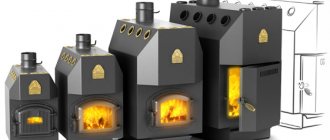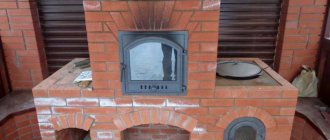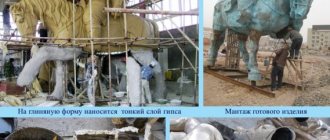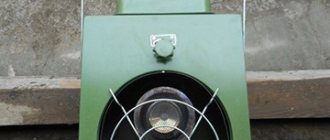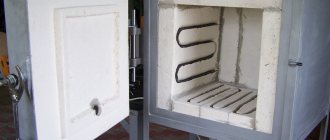Washing in a bathhouse is one of the most striking Russian traditions. Now this process has turned into entertainment and many people install small steam rooms on their property. And in this article we will help you figure out how to make a stove for a sauna. You will learn what types of stoves there are, what principle is used to cook metal stoves and how to lay brick ones. Read to the end and learn all the most important things about sauna stoves.
The stove is the heart of any bath Source pinterest.co.uk
Which sauna stove to choose
All sauna stoves can be divided into several categories. Before you make a stove for a bathhouse, you need to decide what properties it should have.
By material
The oldest material for sauna stoves is fired brick. Many people today pay tribute to traditions by choosing brickwork. But the problem is that such a furnace will be an order of magnitude more expensive and more complex than any other. In addition, it necessarily requires a capital foundation that is not connected with the foundation of the entire building. True, the brick will perfectly retain heat and create the atmosphere of a real Russian bathhouse.
Traditionally, the stove for a Russian bath is made of brick Source pech-pobelomu.ru
It is advisable to use a brick stove only in large baths, because it takes up a lot of space. But there are also compact masonry technologies.
When building a brick stove for a bathhouse, it is better to hire a stove mason, because strict adherence to technology is required. Otherwise, it can become a threat to life and health. However, many people install stoves themselves.
Ready-made metal sauna stoves are gaining popularity. Although they are considered unconventional, they still have their advantages:
- Installing a metal stove is easy and quick
- The entire structure takes up little space
- You can weld a metal stove yourself
- For the manufacture of metal furnaces, materials are often used that would seem worth recycling. For example, scraps of old pipes or rims from trucks
Even powerful metal stoves take up relatively little space Source pinterest.ca
When making a sauna stove, only steel can be used. Cast iron is not suitable for these purposes. Although it conducts heat well, it is fragile and unstable to sudden temperature changes. So, if you splash cold water on a hot cast iron stove, cracks may appear on it.
If you are wondering how to weld a stove for a sauna, then you should remember one rule: the steel for the walls should be as thick as possible. The fact is that this metal cools down very quickly after the end of the firebox, and its greater thickness can somehow compensate for this drawback.
There is a third option - to cover the metal firebox with bricks. In this case, a massive foundation is also not needed. A light base will suffice. An important advantage is that absolutely sealed seams are not required. This option is most optimal for those who want to make a brick stove for a bathhouse on their own.
Such a hybrid can reconcile fans of brick and metal stoves Source inpos.com.ua
This technology will not only retain heat, but will also protect people from infrared radiation from hot metal surfaces. In addition, brick can hide the unsightly appearance of a steel stove.
By fuel
In the context of the question of how to make a stove for a bathhouse, it is impossible not to consider the types of fuel for which the structure will be designed.
Most sauna stoves are designed to burn dried wood. It is believed that such fuel has a healing effect on the human body and creates a pleasant atmosphere. In addition, firewood is relatively inexpensive, burns evenly, providing a constant temperature and produces a lot of heat.
The following types of wood are suitable for heating a sauna stove:
- Hornbeam
- Acacia
- Birch
- Oak
- Spruce
- Linden
Subtle connoisseurs believe that a bathhouse should be heated with birch. Source zen.yandex.uz
There are also stoves that run on gas. Electric sauna heaters for sale. You can add peat and coal to the firebox. But in this case, care must be taken to ensure that combustion products, which have an unpleasant odor, do not penetrate into the room.
Some craftsmen even create liquid sauna stoves. So there are devices that run on diesel fuel.
According to the location of the firebox
There are many drawings on how to make a sauna stove with your own hands from metal or brick. The main difference is the location of the firebox.
The simplest option is when the entire oven is inside the steam room. Firewood is thrown from there. This design is much cheaper and quite easy to use. But there are disadvantages: it is difficult to create a large supply of fuel in a small room. You need to use such a stove carefully, because in cramped spaces you can accidentally get burned on the hot combustion door.
The classic version - the oven is located inside the steam room Source bg.aviarydecor.com
For convenience and safety, the combustion door can be moved to the dressing room. In this case, the heater and the tank for heating water remain in the steam room.
See also: Catalog of bathhouse projects presented at the “Low-Rise Country” exhibition.
According to the heating principle of the heater
In the modern world, constant heating ovens are the most common. Their principle of operation does not involve contact of stones with combustion products. The heater is located either in lattice bodies that cover the surface of the body, or in a welded metal container. Medium-fraction stones, such as coarse gravel, are most suitable here. This system allows you to heat the heater to a temperature of 300-400 degrees without exposing it to soot deposits.
The heater can be placed around the stove body Source greu-vari.com.ua
But one of the main advantages of such stoves is that they are more sensitive to heat. Therefore, you can regulate and maintain the temperature while taking water procedures. When adding a new portion of firewood, the stones will heat up within a few minutes.
There are also so-called periodic heating furnaces. Their operating principle is to remove hot gases through a heater, which is located between the firebox and the chimney. In this way you can heat the stones up to 1000 degrees. But such stoves need to be lit in advance, and you can swim only after the fuel has completely burned out and combustion products have come out.
The preheating design is a classic scheme according to which sauna stoves have been built in Russia for centuries. Round gray stones weighing at least 50 kg were selected for the heater. From time to time they had to be cleaned of soot.
Operating principle of a sauna stove with periodic heating Source lavkaflo.ru
There are also hybrid options. The heater in them is divided into two parts. One is in the path of the exhaust gases, and the other is located outside the housing.
Although this is a rather complex scheme, it combines the advantages of two main types. Hybrid ovens:
- They accumulate heat well.
- Allows you to add firewood while washing.
- They provide dry steam.
Correct temperature in the steam room
A lot can be said about the rules of classic health bath procedures, but in this article we will dwell in detail on the temperature. If we talk about the temperature in the steam room that is most suitable for health in all respects, then this indicator lies
between 50 ° C and 70 ° C. In the classical Russian bathhouse, the stoves were always built of brick and, as a rule, they had closed heaters. This design was simply not able to heat the steam room above 60 ° C and in order to get a good sweat, it would have been necessary to sit in it for too long, but a way out was found.
A ladle of water was poured onto the stones, heated red from the direct flame, which instantly turned into light, hot, finely dispersed steam, most comfortable for both the respiratory tract and the skin. A cloud of steam rose to the ceiling and a person lying on the shelf was gradually doused with small portions of this steam using brooms. With the right technique of pumping steam onto various parts of the body, the steaming process brings not only unforgettable positive sensations, but also the strongest healing effect.
When designing your own sauna, it is important to understand that in addition to the correct temperature to obtain the full range of positive effects of steaming on the body, the sauna must also have a certain humidity. The optimal figure is within 60%. It is this combination of temperature and humidity that provides ideal conditions for the health of the whole body.
It is this combination of temperature and humidity that provides ideal conditions for healing the entire body.
It is possible to ensure that the steam room has both the specified temperature and the correct humidity at the same time only if the stove is in it with a closed heater
To obtain high-quality finely dispersed steam, it is very important that the stones in the furnace are heated to at least 300 °C. And if the heater is open, then when the stones in it are heated to such an extent, the stove itself will be so hot that the temperature of the steam room will go beyond 70 ° C
How to make a metal intermittent heating stove for a sauna
Here we will present the simplest option on how to make a stove for a bath. To manufacture such a device, you will need electric welding and skills to work with it. The best material to use is sheet steel grade ST-3, with a thickness of at least 5 mm. Thinner metal will not hold the temperature well and will burn out quickly.
Drawing of a stove for a periodically heating bath Source optolov.ru
See also: Catalog of companies that specialize in the installation of fireplaces and stoves.
Below we will tell you how to weld a metal sauna stove yourself. You'll learn what to consider to achieve maximum quality.
The optimal dimensions of a metal furnace of this type are 900 mm length, 800 mm height and 600 mm width. Moreover, such a device will be sufficient even for medium-sized steam rooms.
First, the outlet pipe is made. It will require a pipe with a diameter of 115 mm. It can be either short - for connecting a chimney, or long - for putting water heating tanks on it.
Professionals, when asked how to weld a high-quality and durable sauna stove with a water tank and a heater with their own hands, answer that all connections must be made on a corner with a 30 mm shelf. The same profile is suitable for making an internal lattice tray.
The furnace space is divided vertically into three compartments:
- Ash pan - the lowest, smallest compartment with a blower door
- Firebox - a compartment for firewood, separated from the ash pan by a grate
The ash pan and combustion chamber must be separated by a grate Source www.drive2.com
- Kamenka . It is separated from the firebox by a lattice partition.
The doors of the firebox and ash pan are hung on welded hinges. They should definitely be equipped with sliding latches.
The back of the heater needs to be welded with a steel sheet with a hole for the smoke outlet pipe. This pipe should go down 10-12 cm.
You will also need a lid to cover the heater during heating. Here you can use thin sheet metal. A thickness of 0.8-1 mm will be sufficient. The lid should protrude slightly beyond the edges of the heater. It will prevent the stones from cooling quickly and combustion products from escaping into the steam room.
Before washing in the bathhouse, the lid must be removed and the heater left in the open position.
The lid of the heater can be a hinged hatch Source iw.decoratex.biz
Preliminary metal preparation
When making iron stoves for a bath, during preliminary preparation of the material, those parts that heat up more than others (sides, top and door) should be released. To do this, we take the material for the parts of the firebox and heat it until red (for heating, you can use any method convenient for you).
Cool and trim the sheets with a hammer (they may bend after heating and cooling) and double-check the dimensions. If they have changed a little, they need to be straightened. We will avoid this effect (warping of the metal) directly during operation.
Design features of a metal furnace firebox
The next task that worries many: how to make sure that the temperature is maintained evenly and the stove does not produce maximum heat at the very beginning, when the wood burns best? Often you need to constantly add new firewood to raise the temperature again to the desired level. Otherwise, it will be very hot at first, and then it will become completely cool in the bathhouse.
Grate bars are most often installed in the furnace. These grates allow air to pass through well and are designed to heat up the oven quickly. They are made in different ways: by welding metal rods or drilling holes in a sheet of metal.
Firewood is placed on the grate, air draft increases and the combustion process noticeably accelerates. Due to this, the heat is also distributed unevenly. As mentioned above, the top, door and sides of the stove heat up the most. At the same time, the bottom of the structure and the rear wall do not heat up so much.
Often you have to manually regulate the heat - either fill the fire with water, or add wood. And instead of resting, we constantly run back and forth.
What solution? It is simple - place the firewood not on the grate, but on the bottom of the stove. High-quality sealing with mineral wool will also help. You can also make several holes in the firebox door, which will be closed with an additional damper. This way we will regulate the flow of air that gets inside.
One stack of firewood is enough for an hour of heating, plus we get the opportunity to independently regulate the heating level of the stove surface. In this case, there is no need to make grates and an ash pan.
Video description
Here is an interesting video about how to weld a stove for a sauna with your own hands, with a detailed description of the technology:
After the stove is installed in place, it is necessary to lay the stones. It is believed that the classic family norm is 80-100 kg. Round cobblestones with a smooth gray surface are best suited. It is recommended to take stones of different sizes.
Stones for a sauna stove must be carefully selected Source moykamen.com
Laying out stones should begin with the largest and most massive ones. They will not interfere with the upward movement of heat and will store a good supply of heat. After the large ones, medium stones are laid, and only then small ones.
Bath stove
A potbelly stove is a miniature sauna stove that allows you to quickly heat a small room. Due to the small volume of the firebox, such a stove requires constant maintenance of the fire, but otherwise it is not much inferior to a full-scale sauna stove.
You can assemble a potbelly stove for a bath with your own hands from sheet steel and a chimney pipe. To do this, a box is welded from metal. A hole is cut in the pipe for the ash pan, and clamps for the grate are welded above it. Grate rods are added inside the stove, a hole for water supply is added, and a roof is formed with a hole for the chimney. For the heater, lattice sides are formed on the roof. If desired, the potbelly stove can be insulated with brick.
How to lay a brick stove for a bath
How to build a stove in a brick bathhouse with your own hands with a boiler is a complex topic. There are a lot of all sorts of subtleties known only to masters. Not every mason is able to cope with such work. And if you still decide to make a sauna stove with your own hands, we recommend that you study the technology in detail.
How to make mortar for stove masonry
The best binding material for stove mortar is clay. The fact is that when the masonry and seam are made of the same material, their coefficient of thermal expansion is the same. In addition, clay provides good adhesion to brick. True, most often it is not possible to order the type of clay from which the brick itself is made.
Mortar for stove masonry is best mixed using clay. Source aviarydecor.com
To make the structure durable, the seams should be as thin as possible. But at the same time, you need to put in enough mortar so that the brick sets. It is believed that the maximum thickness of the seam should be 5 mm. But if you make it a little thinner, the masonry will be much stronger.
Now about what kind of sand can be added to the solution:
- Only carefully sifted sand will do.
- The size of the granules should not exceed 1 mm.
- The sand should be of uniform color, without silt impurities.
What we need - tools and materials
Before you start making your own sauna stove from a 530 pipe, you should prepare a place to work and stock up on the necessary tools:
welding machine;
- grinder with different attachments;
- electric drill;
- metalworking tools;
- door handles;
- mortise tap;
- asbestos cord.
In addition to tools, you will need the following material:
- Thick-walled metal pipes for fireboxes and water tanks, having a diameter of 500 to 650, a wall thickness of 8-16 mm, and a length of 1.2 to 1.5 meters. Also the pipe through which carbon monoxide will escape, its diameter is 120 - 150, and the wall thickness is 2 - 4 mm.
- A steel pipe where the stones will be placed. The thickness of its walls is 5-8 mm, and the diameter is 350.
- Sheet metal, size 600 by 800 mm, having a thickness of 8 - 12.
- Hinged steel hinges.
- Water pipe - a small piece, suitable diameter ½ or ¾ inch, length 50 - 80 mm, and a ball valve with a similar thread.
- Metal reinforcing bars - 500 mm, diameter 12 - 18.
- Cement.
- Brick.
- Sand.
Video description
Learn more about how to install a sauna stove in the video below:
How to build a firebox
To fire a sauna stove, be sure to use refractory bricks. You can take fireclay material, but it can only be combined with fireclay clay. Under no circumstances should you combine two types of stone, for example, ceramic and fire-resistant. They will expand differently when heated.
The most difficult thing is to correctly fold the firebox of a sauna stove Source liveinternet.ru
When arranging a combustion chamber, bricks must be laid with a gap of 5 mm. After heating, it will expand and occupy all this space. There should be enough space for the grate, because cast iron also expands greatly. It is not worth placing the grate on the solution, because it will have to be changed after a while.
Important! The frame for the firebox door must be installed at the bricklaying stage. It is advisable to cover it with asbestos.
Recommendations for selection
When choosing a specific model, you should take into account the type of fuel that you plan to use. Take note of the size chart above. The grate must be taken in such a way that the rods can easily support the maximum possible weight of one fuel portion. This information can be clarified with a store consultant or specialist.
To clear ash, it is better that the gaps occupy at least 40% of the area of the entire structure. If there are fewer of them, the combustion chamber will not function as efficiently, because the volume of incoming air will be small for good combustion. If ventilation is poor, gases may accumulate. In the case of large gaps, fuel that has not had time to burn out will fall into the gaps along with the ash.
Advantages and disadvantages of the design
A metal stove is widely used for baths due to the many advantages it has:
- Due to its small size, it can be used even in the smallest home baths. Moreover, such structures do not require a separate foundation, which significantly saves time and money on building a furnace. The foundation is built light and simple enough to protect the structure from fire and fire.
- Constant combustion, which can be maintained in the furnace, guarantees uninterrupted thermal conditions. This gives you the opportunity to steam and do all the necessary procedures.
In addition to the advantages of metal products, there are also some disadvantages:
- Due to the fact that there is no material to store energy, the structure cools down quite quickly. To maintain heat, it is recommended to use combined or brick products.
- Such a stove is not suitable for heating a large sauna.
- Fire protection must be installed.
Thus, we can conclude that a metal stove is perfect for small baths. If there is a need to heat a large room, it is better to install another stove.
Scheme and dimensions
When choosing the most preferable pipe option, you need to take into account the internal cross-section and thickness of the steel. To do this, look at the marking: for example, it says “400*7”, which means 400 mm is the diameter, 7 mm is the wall thickness of the profile pipe. For sauna stoves, it is recommended to use pipes with a diameter of 500-600 mm and a thickness of 7-13 mm, but this is not mandatory; the choice of the size of a metal pipe depends on the area of the steam room and the required volume of water.
The most common pipe size for a bath is 530 mm; such installations are considered optimal for standard steam rooms. Some baths cannot boast of spacious steam rooms; they are used, rather, for washing, rather than for long rest, and then small stoves are placed here, for example, with a diameter of 426 mm. If the steam room space allows, then a pipe with a diameter of 630 mm will do.
Vertical
Vertical ovens are usually compact in size. The grate and heater are located under each other, and therefore the diameter of the stove is the diameter of the pipe. Making this variety is not difficult.
Horizontal
Assembling the horizontal version requires more labor-intensive work. For steam rooms, tubular stoves are used; they are distinguished by high strength indicators and create conditions for effective heat transfer into the air of the bath room.
Differences between vertical and horizontal types of furnaces:
- the flame in the vertical pipe travels a short path to the chimney in the upper part of the structure, the hot gases barely touch the sides of the body, but are mostly located in the middle;
- the horizontal version allows hot gas flows to the top of the installation, after which the gas, due to air rarefaction, exits into the chimney;
- the design of the vertical stove efficiently heats the walls of the steam room, but the floor and air at the top of the room are not able to warm up effectively;
- the horizontal version warms up all parts of the space, except for the area adjacent to the floor and the space under the firebox.
Before creating a furnace of any type, but especially a horizontal one, you need to make a competent drawing of the future device. Draw a diagram of the product, indicate all dimensions on it, and strictly follow these instructions. Errors made during the manufacturing stage of the stove can affect not only the performance of the installation, but also threaten the health of vacationers. In addition, this will greatly simplify the installation process.

